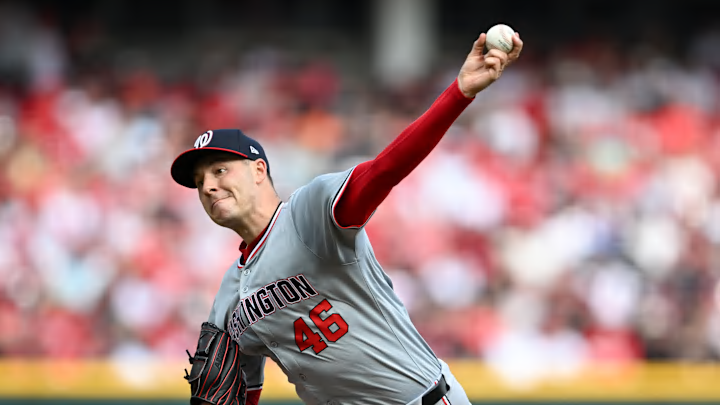Patrick Corbin is a known quantity after 11 big league seasons. If you tracked his value as a player on a graph, it would look like the stock prices of a once popular, now obsolete technology. A company that produces nothing but VHS tapes, perhaps. A solid, trendy start for a young Corbin shot skyward in his late-20s, and he parlayed a couple Arizona All-Star appearances into a $140 million contract in Washington. As we know, Corbin's value peaked with a dominant 2019 and a World Series ring, but it has plummeted ever since. Now, like a VHS tape in your basement, Corbin still exists, but it's been a long time since he's been useful. There are no more shareholders in Patrick Corbin.
And yet, Patrick Corbin still has to climb the pitching mound and go play baseball. There are no championship hopes riding on him, no fans pining for a bright future ahead of him, and no real possibility he could play his way into a trade to a better team. Last season, I suggested Corbin could salvage some value by converting into some sort of multi-inning relief pitcher, maybe? It doesn't really matter at this point. Corbin is in the final year of his contract, which represents the likelihood that it will be his last year in the majors. The only thing at stake, really, is Corbin fighting to not be the very worst pitcher in modern history. That's not hyperbole: Corbin is on a record-setting pace for accumulating losses.
Corbin's value has disappeared on account of his once-sterling arsenal decaying into a rotten mixture of mashable pitches. His fastball is among the most hittable in the league, and his slider has lost every ounce of bite that once made it dangerous. In his long career, Corbin has thrown those two pitches, and those two pitches alone for over 90% of his offerings. He's tossed an occasional changeup and an exceedingly rare eephus-like curveball, but those aren't major parts of his gameplan. He has always lived and died by fastball or by slider, and his 5.62 ERA over the last 4 years can tell you how well that's worked.
Corbin has clearly been stuck in his ways. He's often been stuck on the mound searching for ways to fool hitters who are intimately familiar with his full arsenal, and he's usually been coming up blank. So, in the year 2024, after multiple long summers of getting crushed, Corbin has made an adjustment. Indeed, a new pitch, a cutter, has joined the arsenal that hasn't budged over the last 12+ years. The old, hardened fastball and slider have a baby sibling. Could this have major implications for Patrick Corbin's outlook in 2024 and his career?
Woah. Hold your horses. Corbin proved in his outing against the Reds that he's not exactly unrecognizable from the old Corbin. Pitchers add new pitches all the time, and Corbin isn't exactly reinventing the art of pitching. Plenty of other, better, pitchers already utilize the naturally deceptive sinker-cutter mix that Corbin is essentially trying out for the first time. It's ridiculous that it took a 570 inning sample of Corbin being the league's punching bag for a tweak to be made, even if it ends up working out.
However, none of that makes it a bad idea. Corbin's four-seamer deserves to be thrown in the garbage, and a cutter does play better with his sinker and slider. He threw 19 cutters, 19 sinkers, and 25 sliders against the Reds and managed a few whiffs and a few softly hit balls off of the new pitch. The cutter only averaged 84.5 MPH compared to the slider's 82.3, but it did at times look like something hitters weren't expecting. The veteran pitcher isn't going to become Yu Darvish, but three offerings is better than two!
Here's an optimistic take, as much as that can be possible in a Patrick Corbin article. The Nats fully committing (so far) to having Corbin eschew his longstanding pitch mix could represent the advancement of their pitching brain trust, and whatever departments or decision-makers may be involved. It probably wasn't hard to suggest Corbin change things up, given his numbers across the board, but this is the area the team has desperately needed to catch up to their competitors in. If something this simple means the team will be more experimental and forward-thinking with their pitching staff as a whole, that is a major positive. Whatever data they may have used, however they may have communicated it, this was a necessary change, and they need to be able to make these types of changes.
Could Sean Doolittle have influenced this decision for Corbin? I can only speculate, but his start in his new role with the team does line up with his former teammate Corbin tinkering with a cutter this spring. While we're in the business of shaping arsenals, Trevor Williams could benefit by similarly reducing or ditching his four-seamer that got absolutely walloped last season, and Josiah Gray desperately needs help figuring out how to get his curveball/slider/sweeper situation to actually work. I'd also put working on a splitter for the Nats young pitchers on my wishlist, but I'm getting ahead of myself.
At this point, Patrick Corbin is an experiment in pain tolerance more than he is a baseball player. Through him, I've experienced horror and surprise, dread and amazement, tears and laughter. I can't wait to see his final stats this year, and I can't wait to follow him after this season if he doesn't immediately retire. His new cutter is almost certainly too little, too late, but we're all going to have to watch him give it a go anyways.
